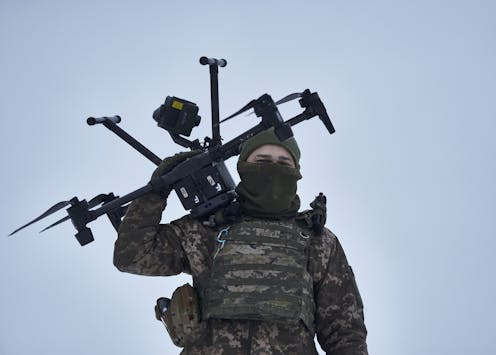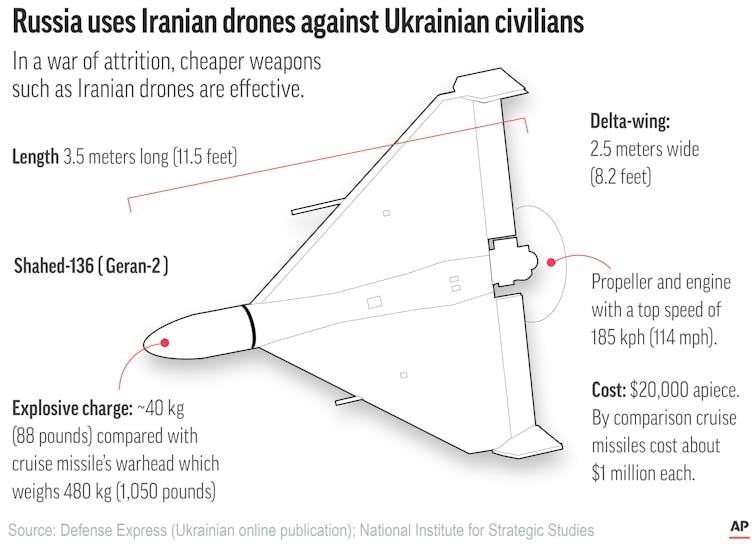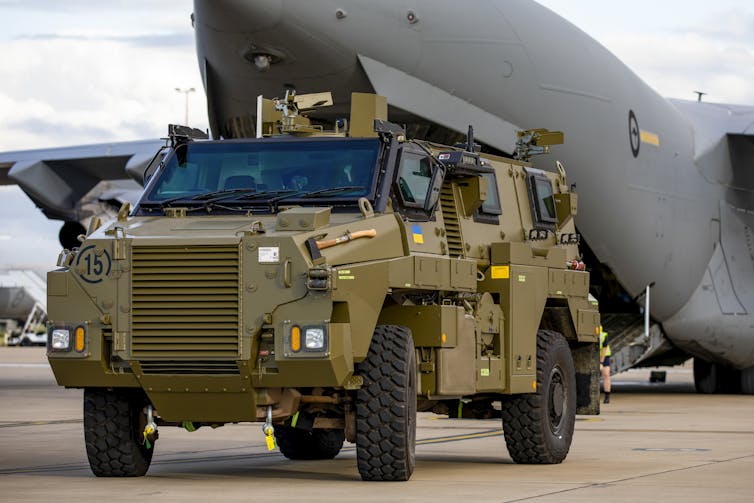Source: The Conversation (Au and NZ) – By Lauren Sanders, Senior Research Fellow on Law and the Future of War, The University of Queensland

Libkos/AP
Ukrainian President Volodymyr Zelensky has been imploring the US, UK and other allies for advanced fighter jets to assist in defending against Russia’s unlawful invasion – a move that could come soon and potentially alter the course of the war. This comes after Germany and the US finally agreed to give more than 300 heavy tanks to Ukraine after much debate.
Some observers have focused on whether providing increasingly sophisticated weaponry is a good idea for strategic reasons, such as whether it risks further escalating the conflict.
But another important issue that has received less attention is whether this technology being gifted to Ukraine complies with international law.
The use of new, untested military technology in Ukraine – even if outwardly for altruistic purposes – could be problematic and even unlawful. In some instances, for example, military suppliers may have a secondary interest: field-testing their new technologies in a real conflict.
Such testing risks harm to civilians and further destruction of Ukrainian infrastructure, as well as causing unnecessary suffering to combatants on both sides of the conflict.
Autonomous drones being used on both sides in Ukraine
Most new weapon technologies being deployed to Ukraine have been tested in controlled environments or through computer simulation systems prior to their use.
While militaries are constantly looking for novel ways to test new technologies to certify them as safe and lawful,field-testing weapons in a combat situation is not generally done until there has been compliance with in-house testing and assurance measures.
However, Russia is not being as cautious. As its supplies dwindle, Moscow is relying on new equipment sourced from the few states that are continuing to trade arms with them.
And some of these technologies, like the Iranian-supplied Shahed-131 and -136kamikaze drones, are apparently being field-tested in Ukraine.
Read more:
Ukraine war: drones are transforming the conflict, bringing Russia on to the frontline
There have long been concerns about whether autonomous drones comply with the laws of war. One major concern is whether they can properly distinguish between combatants and civilians.

AP
Russia is reportedly changing critical functions of their drones to enhance their lethality and destructive capacity.
While Russia has previously indicated it performs some form of weapons testing and review for legal compliance, it seems unlikely this is happening on these new technologies in the limited time before they appear on Ukraine’s front lines.
Advanced drones are also being used on the Ukrainian side, such as the Kargu-2 and Baykatar TB-2 drones supplied by Turkey.
A UN report in 2021 cited the possible use of these same drones in Libya, with concerns over their reliability and their ability to detect the proper target, in compliance with the laws of armed conflict.
What the laws of armed conflict say about testing weapons
Innovation has been key to Ukraine’s success in the conflict thus far.
The gifting of Western military equipment (whether publicly acknowledged or otherwise) has also been a critical factor. Over 32 countries have provided weapons and advanced military technologies to Ukraine.
However, the use of advanced military equipment must be balanced by the need to reduce the harm to both civilians and combatants alike. Both sides have a duty to comply with the laws of armed conflict – and both sides are entitled to the protections of such laws.
The overarching principles of international humanitarian law should ensure, wherever possible that:
-
the impact of conflict – including on combatants – is humane, and
-
harm to civilians and civilian infrastructure is minimised.
When it comes to the testing and evaluation of weapons, the rules of international law are unsettled.
States that have signed up to Additional Protocol I to the Geneva Conventions are obliged to undertake testing of weapons and the “means and method of warfare”. But this is not followed very broadly or consistently.
Some countries like Australia have publicly discussed their weapons review processes that fulfill their obligations under this Protocol.
Other states do it as a matter of good practice. For example, the US is not a signatory to the Protocol, but it still undertakes rigorous testing to ensure its weapons systems are generally compliant with international law.
However, this doesn’t apply to all states who are donating equipment to Ukraine or Russia. In fact, just under half of the 59 countries that are signatories to the Protocol acknowledge they systematically do this kind of testing.
Some states argue these rules on testing weapons should only apply to the country that is using them in armed conflict – not the country that is manufacturing them.
But this view is ignorant of the realities of a state facing an existential crisis and relying on international military aid. Is it both unfair and unrealistic to expect Ukraine to test gifted weapon systems and military equipment when it is fighting for its survival.

LACW Emma Schwenke/Royal Australian Air Force/AP
What Ukraine’s supporters need to do
There are two simple ways for nations gifting weapons to Ukraine to ensure they comply with the laws of armed conflict:
-
checking the weapons or technologies are capable of being used lawfully, and
-
making sure combatants know how to use them in a way that complies with the law.
Australia, for example, has a rigorous weapons review process that tests the compliance of its military technologies. The weaponry on the Bushmaster armoured vehicles sent to Ukraine will have been subject to this process.
Australia is also training Ukrainian forces to use the systems it supplies. While such training serves to bolster Ukraine’s chances of tactical success, it also ensures the soldiers know how to act in compliance with the laws of armed conflict.
It may seem like a minor and technical point to focus on the lawfulness of weapons in the face of Russia’s alleged mass war crimes, and its challenge to the existing rules-based order by invading Ukraine in the first place. But it is in the interests of liberal democracies to reinforce the existing rules-based order, including compliance with international law.
This isn’t to suggest the provision of military aid to Ukraine should cease. Rather, those states contributing to the conflict should be doing their utmost to minimise human harm. This means ensuring new weapons are not field-tested in someone else’s backyard.
![]()
In addition to her role as a Senior Research Fellow at the University of Queensland, Lauren Sanders works as a legal consultant with IWR Pty Ltd, advising Defence industry on international humanitarian law and weapons law issues. Any comments made here are in her personal capacity and do not represent the views of the Australian government or the Australian Defence Force.
– ref. Why Ukraine should not become a testing ground for the world’s new weapons – https://theconversation.com/why-ukraine-should-not-become-a-testing-ground-for-the-worlds-new-weapons-199505






